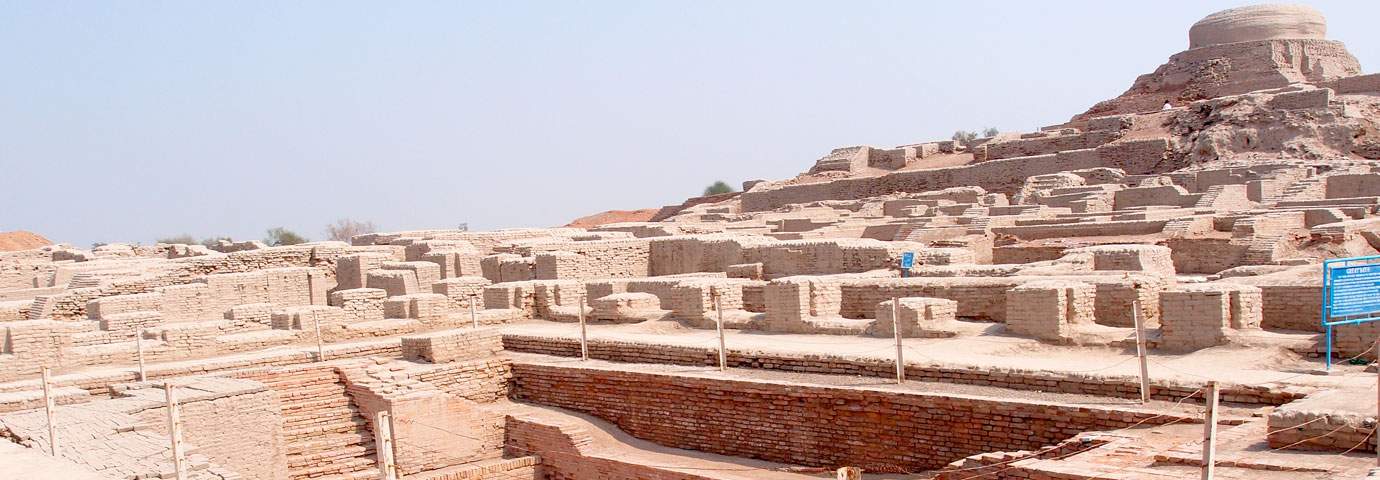Indian History Notes On – Kalibangan – For W.B.C.S. Examination.
As mentioned above, an Early Harappan settlement lies beneath the later remains, and the main Harappan township has a layout strikingly similar to that of Mohenjo-daro and Harappa. In the lower town, excavation has revealed as many as nine building phases. The citadel mound is a parallelogram on a plan of about 430 feet (130 metres) on the east-west axis and 850 feet (260 metres) on the north-south. The whole site has been drastically reduced by brick robbers, but careful excavation has revealed the foundation courses of an accurately laid rhomboid central section with oblong bastions at each corner and smaller bastions on the north and south walls.
The principal access was from the south via a flight of steps. Access from the north was via a narrow postern reached by a stairway, beyond which was a further rhomboid section, having an inset gateway in the northwest corner, near the riverbank. Traces of a brick wall around the lower town were also encountered. The central sector of the citadel contained a series of high brick platforms divided by narrow passages. The upper parts of these platforms had been seriously damaged, and their function is mysterious, but they do not appear to have been the foundation for a granary. The northern sector contained normal domestic housing. A cemetery was discovered a short distance to the west of the town. It may be expected that, when the excavation of this site is published, it will add greatly to knowledge of the Indus civilization.
Lothal
One other excavated site deserves special attention; this is Lothal, a small settlement built on low-lying ground near a tributary of the Sabarmati River on the west side of the Gulf of Khambhat. It appears to have served as a port or trading station. Its layout is distinctive: the site is roughly rectangular, measuring about 1,180 feet (360 metres) on the long north-south axis and 690 feet (210 metres) on the east-west.
It was surrounded by a massive brick wall, which was probably used for flood protection. The southeastern quadrant takes the form of a great platform of brick with earth filling, rising to a height of about 13 feet (4 metres). On this were built a series of further smaller platforms with intersecting air channels, reminiscent of the granary at Mohenjo-daro, with overall dimensions of about 159 by 139 feet (48 by 42 metres). Behind this block were other buildings including a row of 12 bathrooms with connected drains, also strongly reminiscent of those found on the citadel at Mohenjo-daro. The remaining enclosed area was evidently taken up by houses and shops. Among the significant finds were a bead maker’s factory and the shops of goldsmiths and coppersmiths. The main street ran from north to south.
The most unexpected discovery at Lothal, however, was a great brick basin measuring some 718 by 121 feet (219 by 37 metres) with extant brick walls of 15 feet (4.5 metres) in height. This lay east of the settlement, alongside the platform on which the granary block stood. At one end of the basin was a small sluice or spillway with a locking device. The excavator has inferred that the basin was a dock to which ships could be brought from the nearby estuary via an artificial channel that would have been kept clear of silt by controlling the flow of water from the spillway. This view has not been universally accepted; another view is that it provided a source of fresh water for drinking or agriculture. A cemetery was found outside the perimeter of the wall, west of the site.
Please subscribe here to get all future updates on this post/page/category/website


 Toll Free 1800 572 9282
Toll Free 1800 572 9282  mailus@wbcsmadeeasy.in
mailus@wbcsmadeeasy.in



















































































































